Embark on an extraordinary journey to the world’s most captivating scuba diving locations, where vibrant marine life, crystal-clear waters, and breathtaking underwater formations await your discovery. From popular destinations teeming with biodiversity to hidden gems off the beaten path, immerse yourself in the awe-inspiring beauty of the underwater realm.
Whether you’re a seasoned diver or just starting your adventure, this comprehensive guide will provide you with all the essential information you need to plan an unforgettable scuba diving trip. From choosing the right location to packing the necessary gear, we’ve got you covered. So, dive in and let the underwater wonders ignite your passion for exploration.
Popular Scuba Diving Locations
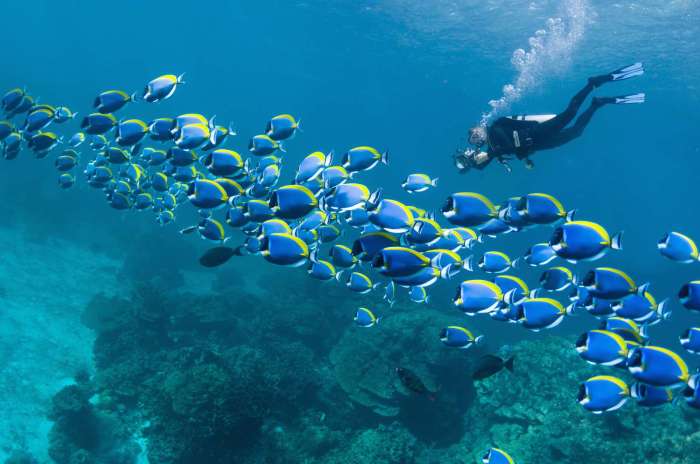
The world’s oceans offer a vast array of stunning underwater destinations that attract scuba divers from around the globe. These locations boast exceptional marine life diversity, crystal-clear waters, and easily accessible dive sites, making them ideal for divers of all experience levels.
Among the most popular scuba diving destinations worldwide are:
The Great Barrier Reef, Australia
- World’s largest coral reef system, stretching over 2,300 kilometers (1,400 miles)
- Home to over 1,500 species of fish, 400 species of coral, and 4,000 species of mollusks
- Offers a wide range of dive sites, from shallow coral gardens to deep drop-offs
Maldives, Scuba diving locations
- Composed of over 1,000 coral islands
- Known for its crystal-clear waters and vibrant marine life
- Offers opportunities for manta ray and whale shark encounters
Galapagos Islands, Ecuador
- Famous for its unique marine ecosystem
- Home to a variety of marine species, including sea lions, marine iguanas, and hammerhead sharks
- Provides opportunities for observing marine life up close
Cozumel, Mexico
- Located off the coast of Mexico’s Yucatan Peninsula
- Features a vast underwater cave system
- Offers excellent visibility and a wide variety of marine life
Bonaire, Netherlands Antilles
- Known for its pristine coral reefs
- Offers shore diving access to over 80 dive sites
- Provides opportunities for underwater photography and videography
Unique Scuba Diving Experiences
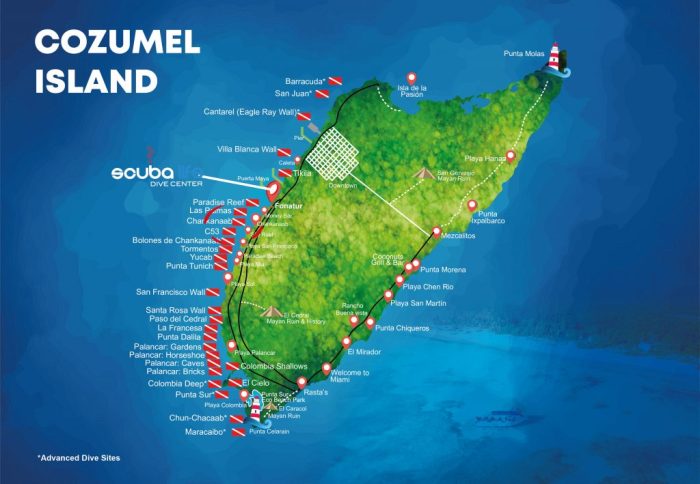
Venture beyond the ordinary and explore the world’s most extraordinary scuba diving destinations. These hidden gems offer unparalleled encounters with marine life and breathtaking underwater formations.
From remote atolls to enigmatic wrecks, discover the challenges and rewards that await in these off-the-beaten-path locations.
Raja Ampat, Indonesia
Immerse yourself in the “Amazon of the Seas” and witness a kaleidoscope of marine biodiversity. With over 1,500 species of fish and 500 species of coral, Raja Ampat boasts some of the most vibrant and pristine reefs on Earth.
Tubbataha Reefs Natural Park, Philippines
Declared a UNESCO World Heritage Site, Tubbataha is a marine sanctuary teeming with sharks, rays, and vibrant corals. Its remote location ensures pristine conditions and encounters with elusive marine species.
Silfra Fissure, Iceland
Experience the unique sensation of diving between two tectonic plates in crystal-clear glacial waters. Silfra offers unparalleled visibility and the opportunity to explore a submerged rift valley.
Yongala Wreck, Australia
Explore the remains of the SS Yongala, a luxury passenger ship that sank in 1911. This iconic wreck is now home to a diverse ecosystem of marine life, including sea turtles, sharks, and stingrays.
Malpelo Island, Colombia
Considered one of the best shark diving destinations in the world, Malpelo is an isolated island in the Pacific Ocean. Encounter hammerhead sharks, silky sharks, and giant manta rays in its nutrient-rich waters.
Safety Considerations for Scuba Diving Locations
Selecting a scuba diving location entails careful consideration of safety factors. Water conditions, weather patterns, and dive site hazards can significantly impact the safety and enjoyment of your dive.
To ensure a safe diving experience, divers must assess and mitigate potential risks before entering the water. Understanding local conditions, adhering to safety protocols, and seeking professional guidance when necessary are crucial for a successful and memorable dive.
Water Conditions
Water conditions play a vital role in dive safety. Visibility, currents, and water temperature can vary greatly depending on the location and time of year. Divers should research these conditions thoroughly and choose a dive site that aligns with their experience level and comfort zone.
- Visibility: Good visibility allows divers to navigate underwater, observe marine life, and identify potential hazards. Poor visibility can increase the risk of disorientation, collisions, and missed dive sites.
- Currents: Strong currents can carry divers away from their intended dive path or make it difficult to control their ascent and descent. Divers should be aware of current patterns and plan their dives accordingly.
- Water Temperature: Cold water can lead to hypothermia and reduce a diver’s endurance. Divers should wear appropriate thermal protection and consider the duration of their dive in relation to the water temperature.
Planning a Scuba Diving Trip
Planning a scuba diving trip can be an exciting and rewarding experience, but it’s important to do your research and make sure you’re prepared. Here’s a comprehensive guide to help you plan the perfect scuba diving trip:
Choosing a Dive Operator
One of the most important decisions you’ll make is choosing a dive operator. There are many different dive operators out there, so it’s important to do your research and find one that’s reputable and experienced.
Here are a few things to consider when choosing a dive operator:
– Experience: How long has the dive operator been in business? Do they have a good safety record?
– Reputation: What do other divers say about the dive operator? Are they known for providing a safe and enjoyable experience?
– Location: Where is the dive operator located? Is it convenient for you to get to?
– Price: How much does the dive operator charge for their services? Is it within your budget?
Booking Accommodations
Once you’ve chosen a dive operator, you’ll need to book your accommodations. There are a variety of different accommodation options available, so you can choose one that fits your budget and needs.
Here are a few things to consider when booking accommodations:
– Location: Where is the accommodation located? Is it close to the dive sites?
– Amenities: What amenities does the accommodation offer? Does it have a pool, restaurant, or other amenities that you’re interested in?
– Price: How much does the accommodation cost? Is it within your budget?
Packing Essential Gear
When packing for your scuba diving trip, it’s important to make sure you have all the essential gear. Here’s a list of essential gear that you’ll need:
– Scuba diving mask
– Snorkel
– Fins
– Buoyancy compensator device (BCD)
– Scuba diving regulator
– Scuba diving tank
– Weight belt
– Dive computer
– Wetsuit or drysuit
– Dive light
– First aid kit
– Sun protection
– Water bottle
– Snacks
Marine Life Encounters: Scuba Diving Locations
Scuba diving offers an unparalleled opportunity to encounter a diverse array of marine life, from the tiniest invertebrates to majestic marine mammals. Divers can expect to see a wide range of species in their natural habitats, each with its unique behaviors and interactions.
To provide a comprehensive overview, we have categorized marine life encounters into three main groups: fish, invertebrates, and mammals. Within each category, we will discuss the different species, their habitats, and any unique behaviors or interactions they exhibit.
Fish
Fish are the most diverse group of marine life, with over 30,000 known species. They come in all shapes, sizes, and colors, and can be found in all types of aquatic environments.
For the environmentally conscious, scuba diving locations offer a chance to explore the underwater world while adhering to eco-friendly travel tips. This includes minimizing waste, choosing sustainable accommodations, and supporting local businesses that prioritize conservation. By adopting these practices, divers can enjoy the beauty of the ocean while ensuring its protection for future generations.
| Species | Habitat | Unique Behaviors/Interactions |
|---|---|---|
| Clownfish | Coral reefs | Form symbiotic relationships with sea anemones |
| Pufferfish | Sandy bottoms | Can inflate themselves to deter predators |
| Eel | Rocky crevices and coral reefs | Can be aggressive if threatened |
| Shark | Open ocean and coastal waters | Apex predators, often feared by humans |
| Ray | Sandy bottoms and coral reefs | Can deliver a painful sting with their tail |
Invertebrates
Invertebrates are animals that lack a backbone. They include a wide range of creatures, from tiny jellyfish to giant squid.
Scuba diving locations offer a unique opportunity to explore the wonders of the underwater world. For those seeking a more sustainable travel experience, consider visiting destinations that prioritize environmental conservation. Check out our guide to sustainable travel destinations to find destinations that balance tourism with protecting marine ecosystems.
Whether you’re a seasoned diver or a beginner, there are plenty of scuba diving locations that cater to all levels of experience.
| Species | Habitat | Unique Behaviors/Interactions |
|---|---|---|
| Jellyfish | Open ocean and coastal waters | Can deliver a painful sting |
| Sea turtle | Coral reefs and seagrass beds | Migrate long distances to nesting beaches |
| Lobster | Rocky crevices and coral reefs | Can grow to be very large |
| Octopus | Rocky crevices and coral reefs | Intelligent creatures that can change color and texture |
| Squid | Open ocean and coastal waters | Can squirt ink to deter predators |
Mammals
Marine mammals are warm-blooded, air-breathing animals that live in the ocean. They include whales, dolphins, seals, and sea lions.
| Species | Habitat | Unique Behaviors/Interactions |
|---|---|---|
| Whale | Open ocean | Can sing complex songs |
| Dolphin | Coastal waters and open ocean | Intelligent creatures that live in pods |
| Seal | Coastal waters and sea ice | Can hold their breath for long periods of time |
| Sea lion | Coastal waters and sea ice | Can bark and growl |
Underwater Photography and Videography
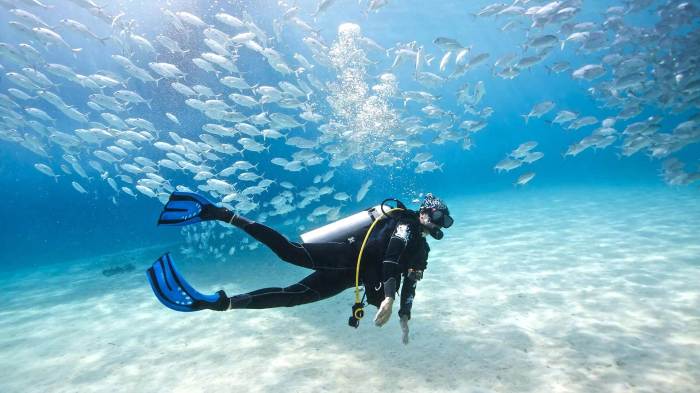
The allure of the underwater world extends beyond its vibrant marine life and breathtaking landscapes. Divers can capture the beauty and wonder of their encounters through underwater photography and videography, creating lasting memories and sharing the marvels of the deep with others.
Underwater photography and videography present unique challenges, such as limited visibility, varying lighting conditions, and the unpredictable behavior of marine life. However, with the right techniques and equipment, divers can overcome these challenges and produce stunning images and videos that showcase the wonders of the underwater realm.
Equipment for Underwater Photography and Videography
- Camera: Divers can choose from a range of cameras, including compact point-and-shoot models, mirrorless cameras, and DSLRs. Each type offers different features and capabilities, so it’s important to select a camera that meets the diver’s needs and skill level.
- Housing: To protect the camera from water damage, it must be housed in a waterproof housing. Housings come in various sizes and materials, and some models are designed for specific camera models.
- Lighting: Natural light can be limited underwater, especially at depth. Divers often use artificial lighting, such as strobes or video lights, to illuminate their subjects and improve image quality.
- Lenses: Different lenses can be used to capture different types of underwater images. Wide-angle lenses are great for capturing expansive scenes, while macro lenses allow divers to focus on small details.
Techniques for Underwater Photography and Videography
- Composition: As in all photography, composition is crucial for creating visually appealing images. Divers should pay attention to the placement of their subjects, the use of negative space, and the overall balance of the image.
- Lighting: Lighting can make or break an underwater image. Divers should experiment with different lighting techniques, such as backlighting, sidelighting, and fill-in flash, to achieve the desired effect.
- Behavior: Marine life can be unpredictable, and divers should be patient and observant to capture natural behaviors. Divers should avoid disturbing the animals and respect their space.
Dive Site Conservation
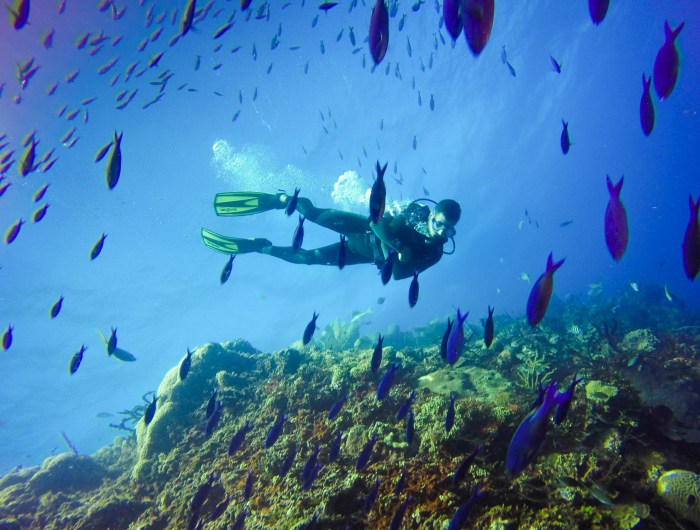
Preserving the beauty and biodiversity of our oceans is crucial for the survival of marine life and the enjoyment of future generations. Scuba divers have a unique opportunity to contribute to conservation efforts and protect the underwater world they explore.
Scuba diving is a fantastic activity for families, but it can be expensive. If you’re looking for a budget-friendly option, consider checking out some of the budget family vacations that are available. These vacations often include scuba diving as an activity, so you can save money on both your accommodation and your diving expenses.
And, of course, you’ll get to experience the amazing underwater world with your family.
Threats to marine ecosystems include pollution, overfishing, climate change, and habitat destruction. These factors can damage coral reefs, deplete fish populations, and disrupt the delicate balance of marine life. Divers can play a vital role in conservation by observing and reporting environmental issues, supporting sustainable fishing practices, and advocating for marine protected areas.
Successful Conservation Initiatives
Several successful dive site conservation initiatives have demonstrated the effectiveness of diver involvement. For example, the Coral Restoration Foundation in Florida has planted over 1 million corals to restore damaged reefs. The Sea Turtle Conservancy in Costa Rica protects nesting beaches and monitors sea turtle populations. These initiatives rely on the support of divers who volunteer their time and resources to make a difference.
Ways for Divers to Get Involved
- Become a citizen scientist: Collect data on marine life, water quality, and environmental conditions to support scientific research and conservation efforts.
- Join conservation organizations: Support organizations dedicated to protecting marine ecosystems through membership, donations, and volunteerism.
- Practice responsible diving: Minimize your impact on the environment by avoiding touching or disturbing marine life, using biodegradable sunscreen, and properly disposing of waste.
- Educate others: Share your knowledge about marine conservation with friends, family, and other divers to raise awareness and inspire action.
Outcome Summary
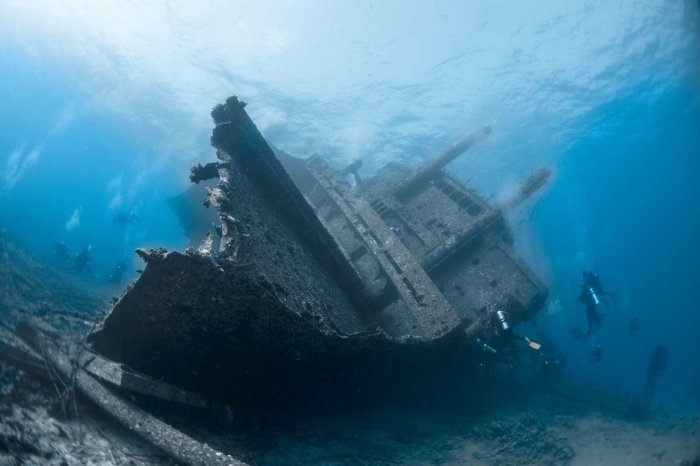
As you conclude your exploration of scuba diving locations, remember that the underwater world is a precious and delicate ecosystem. Embrace your role as an ambassador for marine conservation, promoting responsible diving practices and advocating for the preservation of these awe-inspiring environments. Let your experiences beneath the waves inspire you to become a guardian of the ocean’s wonders, ensuring that future generations can share in the joy and beauty of scuba diving.
FAQ Explained
What are the most popular scuba diving destinations?
The Great Barrier Reef, Australia; Maldives; Red Sea, Egypt; Galapagos Islands, Ecuador; Komodo National Park, Indonesia
What factors should I consider when choosing a scuba diving location?
Marine life diversity, water clarity, dive site accessibility, safety considerations, and your personal preferences
How can I ensure a safe and enjoyable scuba diving experience?
Choose a reputable dive operator, check weather conditions, assess dive site hazards, and follow all safety guidelines